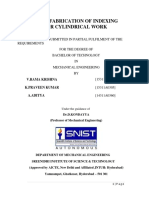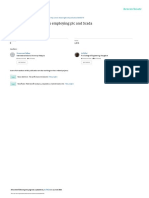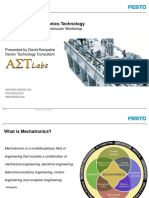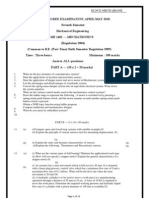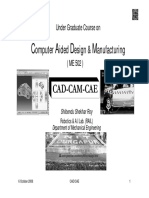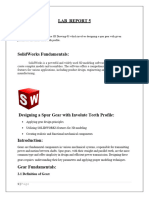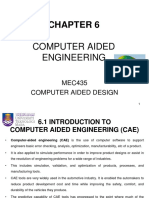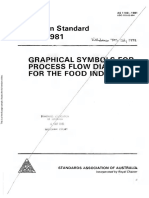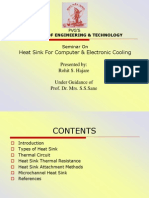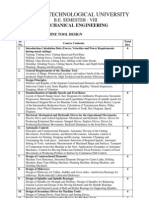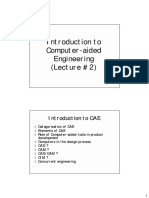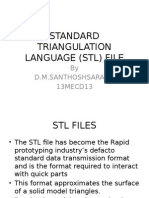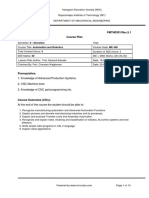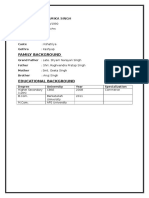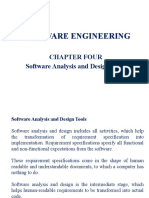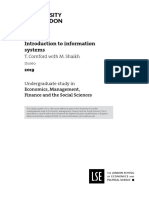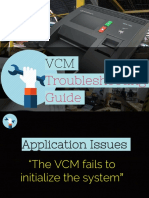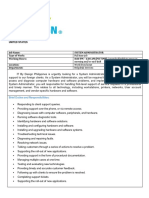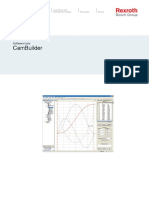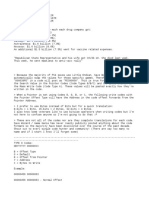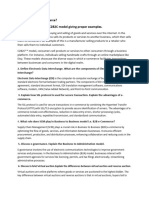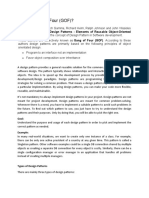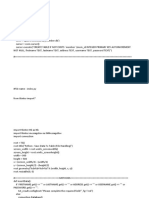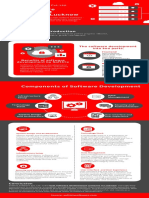Department of Mechanical Engineering
Course File
Subject Automation In Manufacturing(D037713(037))
Branch Mechanical Engineering
Semester 7th
Year 2023-24
Dr. Sanjay G Sakharwade Faculty : Sameer Singh
HOD Asst. Professor
Dept. of Mechanical Engineering Dept. of Mechanical Engineering
RCET, Bhilai RCET, Bhilai
Mo- 7000185224
Email- ssku07652@gmail.com
1
� Course File Content
S. No. Topic Pg No.
1. First page 1
2. Vision & mission of the institute 3
3. Vision & mission of the department 3
4. Syllabus 4
5. Programme Outcomes 5
6. Course’s Outcomes 5
7 Mapping of Programme’s outcomes and Course’s Outcomes 6-7
8. Teaching Plan 8-9
9. Lecture plan & Notes Brief 10-17
10. Question Bank 18-22
11. Previous Year Question Papers 23-25
12. Assignments(I-V) 26-28
2
� Vision & Mission of Institute
Vision
To be recognized among top ranking institutions in the country by 2025 that provides quality education,
pursuance of research and innovation.
Mission
To produce qualified and competent graduates to serve humanity by providing an environment for
holistic development through excellence in education and inculcating ethical values and sense of social
and environmental responsibilities. The institution is committed to disseminate and preserve knowledge
by stimulating intellectual growth through research and innovation.
Vision & Mission of Department
Vision
Globally recognized leader in Mechanical Engineering for excellence in teaching, innovative research
and technology development with societal impact Mission.
Mission
Prepare leaders of tomorrow bestowed with sound fundamentals, strategic thinking and global
awareness. Foster an environment of innovation and high-impact research addressing real-world
problems and catering the needs of the under-served.
3
� Syllabus
UNIT I Introduction:
Why automation, Current trends, CAD, CAM, CIM; Rigid automation: Part handlin
Machine tools. Flexible automation: Computer control of Machine Tools a
Machining Centers, NC and NC part programming, CNC-Adaptive Control, Automat
Material handling. Assembly, Flexible fixturing.
UNIT II Computer Aided Design:
Fundamentals of CAD - Hardware in CAD-Computer Graphics Software and Da
Base, Geometric modeling for downstream applications and analysis methods.
UNIT III Computer Aided Manufacturing:
CNC technology, PLC, Micro-controllers, CNC-Adaptive Control
UNIT IV Low cost automation:
Mechanical & Electro mechanical Systems, Pneumatics and Hydraulics, Illustrati
Examples and case studies.
UNIT V Introduction to Modeling and Simulation:
Product design, process route modeling, Optimization techniques, Case studies
industrial applications.
Textbooks:
1. Automation, Production Systems, and Computer-integrated Manufacturing, Mikell P. Groover,
Prentice Hall
2. Manufacturing – Engineering and Technology, SeropeKalpakjian& Steven R. Schmid, 7th edition,
Pearson
4
� Programme Outcomes (PO’s)
1. An ability to apply knowledge of mathematics, basic sciences, and engineering as applicable to
the fields of Mechanical Engineering.
2. An ability to design and conduct experiments, as well as to organize, analyze, and interpret data
in the fields of mechanical Engineering.
3. An ability to design and construct mechanisms, machines, components and processes to meet
desired requirements, within realistic constraints such as economic, environmental, social, political and
ethical issues.
4. An ability to function on multidisciplinary and culturally diversified teams.
5. An ability to identify, formulate, and solve the problems using sound Mechanical Engineering
principles.
6. An understanding of professional and legal issues and responsibilities as it pertains to
Mechanical Engineering.
7. An ability to effectively communicate technical information in speech, presentation, and in writing.
8. The broad education necessary to understand the impact of computing in a global, economic,
environmental, and public context.
9. Recognition of the need for an ability to engage in lifelong learning to cope-up with rapidly
changing technology.
10. Knowledge of contemporary developments.
Course’s Outcomes
Once the student has successfully complete this course, he/she will be able to answer the following
questions or perform following activities:
a) An ability to apply knowledge of Automation in Manufacturing as applicable to the fields of
Mechanical Engineering.
b) Explain the basic concepts of modeling and simulation.
c) An ability to design and construct mechanisms, machines, components and processes to meet desired
requirements, within realistic constraints such as economic, environmental, social, political and ethical
issues.
d) Explain the basics of computer aided manufacturing.
e) An ability to identify, formulate, and solve the problems using Automation in Manufacturing
principles.
5
� Mapping of Course’s Outcomes with Programme Outcome
CO(a) ↔ PO1
● CO(a): An ability to apply knowledge of Automation in Manufacturing as applicable to the fields of
Mechanical Engineering.
● PO1: An ability to apply knowledge of mathematics, basic sciences, and engineering as
applicable to the fields of Mechanical Engineering.
Justification: CO(a) emphasizes applying automation in manufacturing. This requires a solid foundation
in the principles of mathematics, basic sciences, and core engineering, which is what PO1 targets. The
knowledge base necessary for automation technologies, including sensors, control systems, and
robotics, directly draws from these disciplines.
CO(b) ↔ PO1, PO2
● CO(b): Explain the basic concepts of modeling and simulation.
● PO1: An ability to apply knowledge of mathematics, basic sciences, and engineering as
applicable to the fields of Mechanical Engineering.
● PO2: An ability to design and conduct experiments, as well as to organize, analyze, and interpret
data in the fields of Mechanical Engineering.
Justification: CO(b) involves understanding modeling and simulation, which require foundational
knowledge in mathematics and engineering (PO1). Moreover, creating and using models and
simulations is akin to conducting experiments, where one needs to analyze and interpret data to validate
models, aligning with PO2.
CO(c) ↔ PO3
● CO(c): An ability to design and construct mechanisms, machines, components, and processes to
meet desired requirements, within realistic constraints such as economic, environmental, social, political,
and ethical issues.
● PO3: An ability to design and construct mechanisms, machines, components, and processes to
meet desired requirements, within realistic constraints such as economic, environmental, social, political,
and ethical issues.
Justification: CO(c) is directly related to PO3 as both focus on design and construction within various
constraints. This alignment ensures that students can create practical solutions that are economically
viable, environmentally friendly, and socially acceptable, while also considering political and ethical
issues.
CO(d) ↔ PO1, PO10
● CO(d): Explain the basics of computer-aided manufacturing.
● PO1: An ability to apply knowledge of mathematics, basic sciences, and engineering as
applicable to the fields of Mechanical Engineering.
6
�● PO10: Knowledge of contemporary developments.
Justification: CO(d) involves understanding computer-aided manufacturing, which relies on basic
engineering principles (PO1). Furthermore, this field is continually evolving with new technologies and
practices, requiring knowledge of contemporary developments (PO10).
CO(e) ↔ PO5
● CO(e): An ability to identify, formulate, and solve the problems using Automation in
Manufacturing principles.
● PO5: An ability to identify, formulate, and solve problems using sound Mechanical Engineering
principles.
Justification: CO(e) focuses on problem-solving within the scope of automation in manufacturing. This
directly relates to PO5, which is about applying sound mechanical engineering principles to identify,
formulate, and solve problems. This ensures that students are equipped to handle practical challenges
in the field of automation.
Summary
The detailed mapping and justification align the specific skills and knowledge areas of the course
outcomes (COs) with the broader goals and competencies outlined in the program outcomes (POs). This
comprehensive approach ensures that students not only gain specialized knowledge in automotive air
conditioning but also develop the foundational and professional skills necessary for a successful career
in mechanical engineering
7
� Teaching plan
S.No. Lecture Date of Topic
No. Delivery
UNIT I : Introduction (14 Lectures)
1. 1. Introduction: Why automation, Current trends
2 2 Introduction: Why automation, Current trends
3 3 CAD: Computer Aided Drafting
4 4 CAM: Computer Aided Manufacturing, CIM
5 5 Rigid automation: Part handling
6 6 Machine tools
7 7 Flexible automation
8 8 Computer control of Machine Tools and Machining Centers
9 9 NC : Numerical control
10 10 NC programming
11 11 CNC-Adaptive Control
12 12 CNC Programming
13 13 Automated Material handling
14 14 Assembly, Flexible fixturing
UNIT II : Computer Aided Design(8 Lectures)
15 15 Fundamentals of CAD
16 16 Hardware in CAD
17 17 Computer Graphics Software and Data Base
18 18 Computer Graphics Software and Data Base
19 19 Geometric modeling for downstream applications
20 20 Geometric modeling for downstream applications
21 21 Analysis methods
8
�22 22 Analysis methods
UNIT III :Computer Aided Manufacturing: (9 Lecutres)
23 23 CNC technology
24 24 CNC technology: Current Trends, G codes
25 21 CNC technology: APT Programming
26 26 PLC: Introduction
27 27 PLC: Ladder Logic Software
28 28 Micro-controllers
29 29 Micro-controllers
30 30 CNC-Adaptive Control
31 31 CNC G Code Problem Solving(Exam Based Approach)
UNIT IV :Low cost automation (6 Lectures)
32 32 Low cost automation
33 33 Mechanical & Electro-mechanical Systems
34 34 Pneumatics System
35 35 Hydraulics System
36 36 Illustrative Examples and case studies
37 37 Illustrative Examples and case studies
UNIT V :Introduction to Modeling and Simulation (6 Lectures)
38 38 Introduction to Modeling and Simulation
39 39 Product design: Pathway to Designing a Product
40 40 Product Life Cycle, Methods to optimize product quality
41 41 Optimization techniques
42 42 Case studies & industrial applications
43 43 process route modeling
9
� Lecture Plan
UNIT I: Introduction (14 Lectures)
Lecture 1: Introduction to Automation
● Why Automation?
○ Definition and purpose
1. Automation is the creation and use of technology to produce and deliver
goods and services with minimal human intervention.
○ Benefits: Increased efficiency, reduced labor costs, improved quality
● Current Trends in Automation
○ Industry 4.0 and smart manufacturing
1. Industry 4.0, also known as the Fourth Industrial Revolution, and smart
manufacturing are related concepts that use technologies to improve
manufacturing and supply chain operations.
○ IoT and its impact on automation
Lecture 2: Current Trends in Automation (Continued)
● CAD (Computer-Aided Design)
○ Role in product design
1. Computer-Aided Design (CAD) software helps designers create, modify,
analyze, and optimize product designs. CAD can be used to create 2D
drawings or 3D models of products digitally, which allows designers to
visualize the product's construction before it's physically manufactured.
○ Advantages over manual drafting
1. CAD is more precise, Accurate and fast.
● CAM (Computer-Aided Manufacturing)
○ Integration with CAD
○ Benefits in manufacturing processes
Lecture 3: Computer-Aided Drafting (CAD)
● Introduction to CAD
○ Basic principles
○ Key features and tools
Lecture 4: Computer-Aided Manufacturing (CAM) and CIM
● CAM Overview
○ Role in modern manufacturing
● CIM (Computer Integrated Manufacturing)
10
� ○ Definition and components
○ Benefits of CIM
Lecture 5: Rigid Automation: Part Handling
● Definition and Applications
○ Examples of rigid automation in industries
● Types of Part Handling Systems
○ Conveyors, robots, automated guided vehicles (AGVs)
Lecture 6: Machine Tools
● Introduction to Machine Tools
○ Types of machine tools
○ Role in manufacturing
Lecture 7: Flexible Automation
● Flexible vs. Rigid Automation
○ Benefits of flexibility
○ Examples of flexible automation systems
Lecture 8: Computer Control of Machine Tools and Machining Centers
● Overview
○ Computer Numerical Control (CNC)
○ Direct Numerical Control (DNC)
Lecture 9: Numerical Control (NC)
● Definition and History
○ Evolution of NC systems
11
� ● Basic Components of NC Systems
Lecture 10: NC Programming
● Introduction to NC Programming
○ Basics of coding for NC machines
○ Commonly used codes and commands
Lecture 11: CNC-Adaptive Control
● What is Adaptive Control?
○ Importance in CNC
○ Examples and benefits
Lecture 12: CNC Programming
● Detailed CNC Programming
○ G-codes and M-codes
○ Programming for different operations
Lecture 13: Automated Material Handling
● Definition and Importance
○ Types of automated material handling systems
○ Benefits and applications
Lecture 14: Assembly and Flexible Fixturing
● Automated Assembly Systems
○ Types and examples
● Flexible Fixturing
○ Importance in automation
○ Examples and applications
12
�UNIT II: Computer Aided Design (8 Lectures)
Lecture 15: Fundamentals of CAD
● Introduction to CAD Systems
○ Components and functions
● CAD Software Overview
○ Popular CAD software (AutoCAD, SolidWorks, CATIA)
Lecture 16: Hardware in CAD
● Components of CAD Hardware
○ Input devices (mouse, digitizers)
○ Output devices (printers, plotters)
Lecture 17: Computer Graphics Software and Database
● Basics of Computer Graphics
○ Types of graphics used in CAD
● Role of Databases in CAD
○ Storing and managing design data
Lecture 18: Computer Graphics Software and Database (Continued)
● Data Exchange Standards
○ DXF, IGES, STEP formats
● Database Management in CAD
Lecture 19: Geometric Modeling for Downstream Applications
● Introduction to Geometric Modeling
○ Types: Wireframe, Surface, Solid modeling
● Applications in Manufacturing
Lecture 20: Geometric Modeling for Downstream Applications (Continued)
● Detailed Techniques
○ Feature-based modeling
○ Parametric modeling
Lecture 21: Analysis Methods
● Introduction to Analysis Methods
○ Finite Element Analysis (FEA)
○ Computational Fluid Dynamics (CFD)
Lecture 22: Analysis Methods (Continued)
13
� ● Case Studies
○ Examples of analysis in product design
● Importance in CAD
UNIT III: Computer Aided Manufacturing (9 Lectures)
Lecture 23: CNC Technology
● Introduction to CNC
○ Components and functions
● Benefits of CNC Technology
Lecture 24: CNC Technology: Current Trends and G-codes
● Recent Developments in CNC
○ Advanced CNC systems
● Introduction to G-codes
○ Basic commands and their uses
Lecture 25: CNC Technology: APT Programming
● What is APT Programming?
○ Advantages over traditional programming
● Examples and Applications
14
�Lecture 26: PLC: Introduction
● What is a PLC?
○ Components and operation
● Importance in Automation
Lecture 27: PLC: Ladder Logic Software
● Introduction to Ladder Logic
○ Basic concepts and symbols
● Programming with Ladder Logic
Lecture 28: Micro-controllers
● Overview of Micro-controllers
○ Types and applications
● Role in Automation
Lecture 29: Micro-controllers (Continued)
● Detailed Examples
○ Using micro-controllers in manufacturing systems
Lecture 30: CNC-Adaptive Control
● Adaptive Control Techniques
○ Examples and benefits in manufacturing
15
�Lecture 31: CNC G Code Problem Solving (Exam Based Approach)
● Practical Exercises
○ Common problems and solutions
● Exam Preparation
UNIT IV: Low Cost Automation (6 Lectures)
Lecture 32: Low Cost Automation
● Introduction and Importance
○ Benefits of low-cost solutions
● Examples in Industries
Lecture 33: Mechanical & Electro-mechanical Systems
● Overview of Mechanical Systems
○ Types and applications
● Electro-mechanical Systems
○ Integration and examples
Lecture 34: Pneumatics System
● Components of Pneumatic Systems
○ Compressors, valves, actuators
● Applications in Automation
Lecture 35: Hydraulics System
● Introduction to Hydraulics
○ Components and operation
● Comparison with Pneumatics
Lecture 36: Illustrative Examples and Case Studies
● Examples of Low-Cost Automation
○ Detailed case studies from industry
16
�Lecture 37: Illustrative Examples and Case Studies (Continued)
● Discussion on Success Stories
○ Lessons learned from real-world applications
UNIT V: Introduction to Modeling and Simulation (6 Lectures)
Lecture 38: Introduction to Modeling and Simulation
● Definition and Importance
○ Differences between modeling and simulation
● Applications in Manufacturing
Lecture 39: Product Design: Pathway to Designing a Product
● Steps in Product Design
○ Conceptualization, development, testing
● Role of Modeling
Lecture 40: Product Life Cycle, Methods to Optimize Product Quality
● Product Life Cycle
○ Stages and management
● Quality Optimization Techniques
○ Methods and tools
Lecture 41: Optimization Techniques
● Overview of Optimization
○ Importance in manufacturing
● Common Techniques
○ Linear programming, genetic algorithms
Lecture 42: Case Studies & Industrial Applications
● Examples of Modeling and Simulation
○ Detailed case studies
● Impact on Manufacturing Processes
Lecture 43: Process Route Modeling
● Introduction to Process Route Modeling
○ Definition and applications
● Benefits in Manufacturing
17
� Question Bank
UNIT I: Introduction (14 Lectures)
4-Mark Questions:
1. Define automation. Why is automation important in manufacturing industries?
2. What are the current trends in automation?
3. Explain the concept of Computer-Aided Drafting (CAD).
4. What is Computer-Aided Manufacturing (CAM)?
5. Define rigid automation. How is it used in part handling?
6. What are machine tools? Provide examples.
7. Explain the difference between rigid and flexible automation.
8. What is numerical control (NC)?
9. Briefly describe NC programming.
10. What is automated material handling?
8-Mark Questions:
1. Differentiate between flexible and fixed automation with examples.
2. Discuss the various reasons for implementing automated systems in manufacturing.
3. Describe the role of CAD in modern manufacturing processes.
4. Explain the benefits and challenges of implementing CAM in industries.
5. Discuss the computer control of machine tools and machining centers.
6. What is CNC? Explain adaptive control in CNC.
7. Describe CNC programming and its importance in manufacturing.
8. Explain the process of automated material handling and its benefits.
9. Discuss the various components involved in assembly and flexible fixturing.
10. Explain how numerical control has evolved over time and its impact on manufacturing.
UNIT II: Computer Aided Design (8 Lectures)
4-Mark Questions:
1. What are the fundamentals of CAD?
2. List the hardware components used in CAD systems.
3. What is computer graphics software?
4. Explain the importance of a database in CAD systems.
5. Define geometric modeling.
18
� 6. What are the downstream applications of geometric modeling?
7. Briefly describe analysis methods used in CAD.
8. What are the benefits of using CAD in product design?
9. Explain the role of CAD in improving product quality.
10. What are the different types of CAD software available?
8-Mark Questions:
1. Discuss the various hardware components essential for CAD.
2. Explain the role of computer graphics software in CAD systems.
3. Describe the types of databases used in CAD and their importance.
4. Explain geometric modeling and its applications in CAD.
5. Discuss the different analysis methods used in CAD and their significance.
6. Explain how CAD can be used for product design optimization.
7. Describe the process of geometric modeling for downstream applications.
8. Discuss the challenges and solutions in implementing CAD systems.
9. Explain how CAD software has evolved over the years.
10. Discuss the future trends in CAD and their potential impact on manufacturing.
UNIT III: Computer Aided Manufacturing (9 Lectures)
4-Mark Questions:
1. What is CNC technology?
2. Explain the current trends in CNC technology.
3. What are G codes in CNC programming?
4. Define APT programming.
5. What is PLC? Provide an introduction.
6. Explain ladder logic software.
7. What are microcontrollers?
8. Describe the role of CNC in adaptive control.
9. What are the benefits of using microcontrollers in manufacturing?
10. Explain the significance of G code problem-solving in CNC.
8-Mark Questions:
1. Discuss the impact of CNC technology on modern manufacturing.
2. Explain the various components and functions of PLC.
3. Describe the process of ladder logic programming and its applications.
4. Explain APT programming in detail.
19
� 5. Discuss the role of CNC in improving manufacturing processes.
6. Describe the advantages and challenges of using micro-controllers in automation.
7. Explain the process of adaptive control in CNC technology.
8. Discuss the importance of G codes and M codes in CNC programming.
9. Explain how CNC technology has evolved over the years.
10. Discuss the future trends in CNC technology and their potential impact on
manufacturing.
UNIT IV: Low Cost Automation (6 Lectures)
4-Mark Questions:
1. Define low-cost automation.
2. What are mechanical systems in low-cost automation?
3. Explain electro-mechanical systems in automation.
4. What are the components of a pneumatic system?
5. Describe the role of hydraulics in low-cost automation.
6. Provide examples of low-cost automation.
7. Explain the benefits of low-cost automation.
8. What are the challenges of implementing low-cost automation?
9. Discuss the importance of case studies in low-cost automation.
10. What is flexible fixturing?
8-Mark Questions:
1. Discuss the various components of low-cost automation.
2. Explain the role of mechanical systems in low-cost automation with examples.
3. Describe the use of electro-mechanical systems in automation.
4. Explain the components and functioning of a pneumatic system.
5. Discuss the application of hydraulics in low-cost automation with examples.
6. Explain the process and benefits of implementing low-cost automation in manufacturing.
7. Discuss the challenges faced in low-cost automation and possible solutions.
8. Provide detailed examples of low-cost automation in industries.
9. Explain the importance of flexibility in fixturing and its impact on automation.
10. Discuss future trends in low-cost automation and their potential benefits.
20
�UNIT V: Introduction to Modeling and Simulation (6 Lectures)
4-Mark Questions:
1. Define modeling in the context of manufacturing.
2. What is simulation in manufacturing?
3. Explain the product design process.
4. What is the product life cycle?
5. Describe methods to optimize product quality.
6. What are optimization techniques in manufacturing?
7. Explain the role of case studies in modeling and simulation.
8. What is process route modeling?
9. Discuss the importance of simulation in manufacturing.
10. What are the benefits of using modeling in product design?
8-Mark Questions:
1. Explain the steps involved in product design and development.
2. Discuss the various techniques used for modeling in CAD/CAM.
3. Explain the significance of simulation in manufacturing processes.
4. Describe the product life cycle and its importance in product design.
5. Discuss the methods used to optimize product quality in manufacturing.
6. Explain the different optimization techniques used in manufacturing.
7. Provide detailed examples of industrial applications of modeling and simulation.
8. Discuss the role of process route modeling in manufacturing.
9. Explain the challenges and solutions in implementing simulation in manufacturing.
10. Discuss future trends in modeling and simulation and their potential impact on
manufacturing.
21
�NC & CNC Programming Question:
22
�Previous Year Question Paper
23
�24
�25
� Assignments
ASSIGNMENT I (Unit I)
Q1. Define automation. Why is automation important in manufacturing industries?
Q2. What are the different types of automation? Discuss them briefly.
Q3. Explain the basic elements of an automated system.
Q4. What is adaptive control? What are the benefits of adaptive control?
Q5. What is the difference between CNC DNC and Adaptive control machining
system?
Q6. What are the types of material handling equipment and explain it?
Q7. Write the various Automation strategies
Q8 Differentiate between flexible and fixed automation
Q9. Explain automated material handling assembly
Q10 What is NC and NC part programming?
ASSIGNMENT II(Unit II)
Q1. What is CAD system hardware?
Q2. What is a database? Explain the various database models of an object.
Q3. What are the geometric modelling of the downstream application.
Q4. What are the differences between wire modelling and surface modelling.
Q5. What are the limitations of CAD software?
Q6. Briefly explain the principles and the functions that are expected to be served
by numerical control in machine tools.
Q7. Explain “Automation and CAD/CAM “ both act as a complete system for design
and manufacturing.
Q8 Give a brief description of the popular database models.
26
�Q9. Explain in brief CAD system hardware and software for graphic systems.
Q10 Examine what is meant by product data management? Explain why it is
important in CAD/CAM integration?
ASSIGNMENT III(Unit III)
Q1. Describe the Adaptive control with its two types.
Q2. Describe application of PLC in control drives and power systems.
Q3. Briefly explain the principle and the function that are expected to be served by
numerical control in machine tools.
Q4. Write down the differences between PLC and Computer.
Q5. Name some of the important applications of CAM in manufacturing planning.
Q6. What is computer- aided design?Give advantages of DNC over CNC
machines.
Q7. What is meant by adaptive control?
Q8 Explain CNC Technology in details.
Q9. Explain PLC with proper block diagram.
Q10 Write short notes on Microcontroller
ASSIGNMENT IV (Unit IV)
Q1. Enumerate different components in the hydraulic system.
Q2. Explain automation in industry with illustrative examples.
Q3. What are the differences between mechanical and electro- mechanical system?
Q4. Compare pneumatic and hydraulics system.
Q5. Give examples of different Low cost Automation Systems.
Q6. Explain in detail the low cost Automation.
Q7. What is a Pneumatic system? Basic pneumatic automation components.
Advantages and limitations of the pneumatic system?
Q8 What are the important pneumatic components used in automated system?
Discuss briefly.
Q9. Explain low cost automation for a case study on pneumatic grippers for pick
27
� and place type.
Q10 What are the avenues of low cost automation?
ASSIGNMENT V(Unit V)
Q1. Explain the term simulation.
Q2. Enlist the various solid modelling techniques used in CAD/CAM.
Q3. Give the steps in product design and process development.
Q4. Write down the industrial applications of computers in design.
Q5. What is Modelling?
Q6. What are some common types of models that can be used with simulation
techniques?
Q7. What is the CAD to CAM integration process? What are the benefits of
integration CAD and CAM?
Q8 What is the role of simulation in product design,Write its benefits.
Q9. What are the various optimization techniques?
Q10 Explain the process of product design.
28
